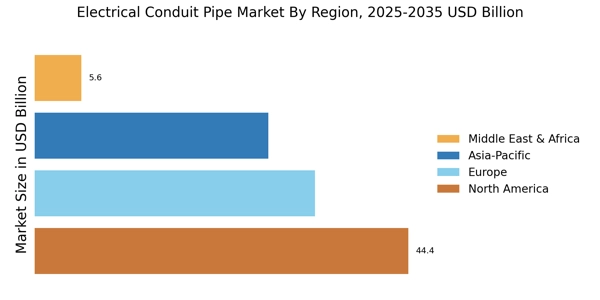Increased Construction Activities
The resurgence of construction activities across various sectors is a key driver for the Electrical Conduit Pipe Market. With the ongoing development of residential, commercial, and industrial projects, the demand for electrical conduits is on the rise. According to recent data, the construction industry is projected to grow at a rate of 4% annually, leading to heightened requirements for electrical installations. This growth is further fueled by government initiatives aimed at boosting infrastructure development, which is likely to result in increased consumption of electrical conduit pipes in the coming years.
Rising Demand for Renewable Energy
The increasing emphasis on renewable energy sources is driving the Electrical Conduit Pipe Market. As countries strive to meet energy efficiency targets, the installation of solar panels and wind turbines necessitates the use of electrical conduits for safe and efficient wiring. This trend is reflected in the projected growth of the renewable energy sector, which is expected to reach a market size of over 2 trillion USD by 2030. Consequently, the demand for electrical conduit pipes, which protect and route electrical wiring, is likely to surge, thereby enhancing the overall market landscape.
Technological Innovations in Materials
Advancements in materials technology are significantly impacting the Electrical Conduit Pipe Market. The introduction of lightweight, durable, and corrosion-resistant materials is enhancing the performance and longevity of electrical conduits. For example, the development of PVC and HDPE conduits has revolutionized the market by offering superior protection against environmental factors. This innovation is expected to drive market growth, as construction and electrical companies increasingly prefer these advanced materials for their projects. The market for electrical conduits is projected to grow at a CAGR of approximately 5% over the next five years, driven by these technological advancements.
Urbanization and Smart City Initiatives
The rapid pace of urbanization and the rise of smart city initiatives are propelling the Electrical Conduit Pipe Market. As urban areas expand, the demand for efficient electrical infrastructure becomes paramount. Smart cities require advanced electrical systems to support technologies such as IoT and smart grids, which in turn necessitate the use of reliable conduit systems. This trend is reflected in the increasing investments in urban infrastructure, with estimates suggesting that smart city investments could exceed 2 trillion USD by 2025. Such developments are likely to create substantial opportunities for growth within the electrical conduit market.
Regulatory Compliance and Safety Standards
Stringent regulatory frameworks and safety standards are pivotal in shaping the Electrical Conduit Pipe Market. Governments and regulatory bodies are increasingly mandating the use of specific materials and installation practices to ensure safety in electrical installations. For instance, the National Electrical Code (NEC) outlines requirements for conduit usage, which directly influences market dynamics. As compliance becomes non-negotiable, manufacturers are compelled to innovate and adapt their products to meet these standards, potentially leading to an uptick in market growth as companies seek to align with regulatory expectations.


















Leave a Comment